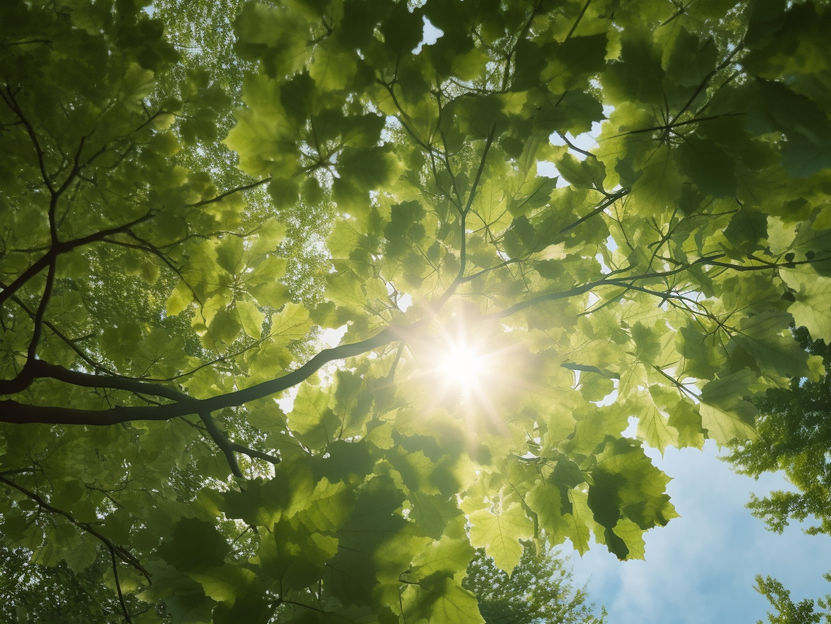Photosynthesis: varying roads lead to the reaction center
Chemists use high-precision quantum chemistry to study key elements of super-efficient energy transfer in an important element of photosynthesis
photosynthesis is the motor of all life on Earth. Complex processes are required for the sunlight-powered conversion of carbon dioxide and water to energy-rich sugar and oxygen. These processes are driven by two protein complexes, photosystems I and II. In photosystem I, sunlight is used with an efficiency of almost 100%. Here a complex network of 288 chlorophylls plays the decisive role. A team led by LMU chemist Regina de Vivie-Riedle has now characterized these chlorophylls with the help of high-precision quantum chemical calculations – an important milestone toward a comprehensive understanding of energy transfer in this system and potentially being able to exploit its efficiency in artificial systems in the future.

Symbolic image
Computer-generated image
The chlorophylls in photosystem I capture sunlight in an antenna complex and transfer the energy to a reaction center. There, the solar energy is used to trigger a redox process – that is to say, a chemical process whereby electrons are transferred. The quantum yield of photosystem I is almost 100%, meaning that almost every absorbed photon leads to a redox event in the reaction center.
Simulation under natural conditions
“Although the complicated energy transfer inside the photosystem has been studied for decades, there is no consensus up to today about the exact mechanism,” says de Vivie-Riedle. To gain deeper insights, the researchers simulated the light excitation of all chlorophylls in a model of photosystem I embedded in a lipid membrane. A highly accurate multireference method was used to calculate the electronic excitations. Compared to earlier studies, this approach allows the photosystem I to be described on the basis of state-of-the-art methodology. The complicated calculations were made possible by the supercomputer at the Leibniz Supercomputing Centre.
The results of the study, which is featured on the cover of the journal Chemical Science, reveal so-called “red chlorophylls” that absorb light at slightly lower energies than their neighbors due to ambient electrostatic effects. As a result, their absorption spectrum is red-shifted. Analogously, the researchers also identified energy barriers between the antenna complex and the reaction center, among other places. “This seems surprising at first glance because there is no obvious gradient along which energy is transferred from the antenna complex to the reaction center,” explains lead author Sebastian Reiter.
Fluctuations overcome energy barriers
Under physiological conditions, however, the entire photosystem I is subject to thermal fluctuations that overcome these energy barriers, as the relative energies of the chlorophylls change with respect to each other. In this way, new pathways into the reaction center can constantly open up, while others close. This, according to the core thesis of the authors, could be the key to the high efficiency of photosystem I.
“Our atomistic simulation of these processes enables a microscopic understanding of the system and its dynamics in its natural environment, complementary to experimental approaches,” concludes Regina de Vivie-Riedle, who is also a member of the e-conversion cluster of excellence. One of the goals of the cluster is to one day transfer the efficiency of natural photocatalysts to artificial nano-bio hybrid systems for applications such as the production of hydrogen as an energy carrier or the conversion of carbon monoxide into fuel. This requires a better understanding of the energy transfer mechanism. With their results on photosystem I, the scientists have now taken an important step toward the realization of this goal.
Original publication
Other news from the department science
Most read news
More news from our other portals
See the theme worlds for related content
Topic world Synthesis
Chemical synthesis is at the heart of modern chemistry and enables the targeted production of molecules with specific properties. By combining starting materials in defined reaction conditions, chemists can create a wide range of compounds, from simple molecules to complex active ingredients.

Topic world Synthesis
Chemical synthesis is at the heart of modern chemistry and enables the targeted production of molecules with specific properties. By combining starting materials in defined reaction conditions, chemists can create a wide range of compounds, from simple molecules to complex active ingredients.



























































